Effects of Zr, Y on the Microstructure and Properties of As-Cast Cu-0.5Y-xZr (wt.%) Alloys
Abstract
:1. Introduction
2. Materials and Methods
2.1. Alloy Preparation
2.2. Compositional Analysis and Microstructural Characterization
2.3. Mechanical Tests
3. Results and Discussion
4. Conclusions
- (1)
- In the as-cast Cu-0.5Y-0.1Zr (wt.%) alloy, the precipitated phases were the Cu5Y/Cu5Zr phase. The precipitated phases ranged from 10 to 70 nm in size, mainly distributed at the grain boundaries;
- (2)
- Both the tensile strength and elongation of the as-cast Cu-0.5Y-xZr (wt.%) alloys increased when Zr content increased from 0.05 to 0.1 wt.%;
- (3)
- Due to Hall–Petch strengthening and precipitation strengthening of the Cu5Y/Cu5Zr phases, the addition of Y and Zr can significantly improve the mechanical properties of as-cast pure copper. The UTS and elongation of the as-cast Cu-0.5Y-0.1Zr (wt.%) alloys were 225 MPa and 22.5%, respectively.
Author Contributions
Funding
Acknowledgments
Conflicts of Interest
References
- Borodianskiy, K. Effect of carbon nanotubes’ addition on mechanical properties and thermal conductivity of copper. J. Mater. Sci. 2019, 54, 13767–13774. [Google Scholar] [CrossRef]
- Davis, J.R. Copper and Copper Alloys, 1st ed.; ASM International: Cleveland, OH, USA, 2001; pp. 3–8. [Google Scholar]
- Xie, M.; Liu, J.; Lu, X.; Den, Z.; Jang, H.; Lu, F. Study of rapidly solidified Cu-Cr-RE alloys. Sci. Technol. Adv. Mater. 2001, 2, 79–82. [Google Scholar] [CrossRef]
- Lu, H. Effect of yttrium on the microstructure and mechanical properties of copper and Cu-Si Alloys. Chin. Rare Earths 1996, 17, 12–15. [Google Scholar]
- Pan, Z.Y.; Chen, J.B.; Li, J.F. Microstructure and properties of rare earth-containing Cu-Cr-Zr alloy. Trans. Nonferrous Met. Soc. China 2015, 25, 1206–1214. [Google Scholar] [CrossRef]
- Xie, M.; Liu, J.L.; Lu, X.Y.; Shi, A.; Den, Z.M.; Jang, H.; Zheng, F.Q. Investigation on the Cu-Cr-RE alloys by rapid solidification. Mater. Sci. Eng. A 2001, 304–306, 529–533. [Google Scholar] [CrossRef]
- Yin, J.Y.; Zhang, M.; Chen, X.F. Effect of Y on the hardness and electrical conductivity of Cu-Cr alloy. Heat Treat. Met. 2004, 4, 32–35. [Google Scholar]
- Carro, G.; Muñoz, A.; Monge, M.A.; Savoini, B.; Galatanu, A.; Galatanu, M.; Pareja, R. Thermal conductivity and diffusivity of Cu-Y alloys produced by different powder metallurgy routes. Fusion Eng. Des. 2017, 124, 1156–1160. [Google Scholar] [CrossRef]
- Okamoto, H. Cu-Zr (copper-zirconium). J. Phase Equilib. Diffus. 2008, 29, 204. [Google Scholar] [CrossRef]
- Dong, Z.L.; Tang, X.Y.; Hori, S. Aging precipitation of Cu-Zr and Cu-Zr-Si alloys and affected by cold working. Acta Metall. Sin. 1989, 25, 78–81. [Google Scholar]
- Wang, Q.J.; Liu, D.; Tong, L.B.; Zhou, Y.; Wang, W.; Zhou, H.X.; Fan, R.X. Enhanced stress corrosion cracking resistance of ultrafine-grained Cu-Cr-Zr Alloy Fabricated via equal-channel angular pressing. Metals 2019, 9, 824. [Google Scholar] [CrossRef]
- Chen, X.H.; Liu, P.; Tian, B.H.; Zhang, Y.; Jia, S.G.; Ren, F.Z.; Jing, X.T. Thermal stability of Cr filaments in Cu-Cr in situ composites. Trans. Nonferrous Met. Soc. China 2009, 19, 328–333. [Google Scholar]
- Watanabe, C.; Monzen, R.; Tazaki, K. Mechanical properties of Cu-Cr system alloys with and without Zr and Ag. J. Mater. Sci. 2008, 43, 813–819. [Google Scholar] [CrossRef]
- Ye, Y.X.; Yang, X.Y.; Wang, J.; Zhang, X.K.; Zhang, Z.L.; Sakai, T. Enhanced strength and electrical conductivity of Cu-Zr-B alloy by double deformation-aging process. J. Alloy. Compd. 2014, 615, 249–254. [Google Scholar] [CrossRef]
- Peng, L.J.; Xie, H.F.; Huang, G.J.; Li, Y.F.; Yin, X.Q.; Feng, X.; Mi, X.J.; Yang, Z. The phase transformation and its effects on properties of a Cu-0.12wt% Zr alloy. Mater. Sci. Eng. A 2015, 633, 28–34. [Google Scholar] [CrossRef]
- Huang, F.X.; Ma, J.S.; Ning, H.L.; Geng, Z.T.; Lu, C.; Guo, S.M.; Yu, X.T.; Wang, T.; Li, H.; Lou, H.F. Analysis of phases in a Cu-Cr-Zr alloy. Scr. Mater. 2003, 48, 97–102. [Google Scholar]
- Nagorka, M.S.; Levi, C.G.; Lucas, G.E.; Ridder, S.D. The potential of rapid solidification in oxide-dispersion-strengthened copper alloy development. Mater. Sci. Eng. A 1991, 142, 277–289. [Google Scholar] [CrossRef]
- Zhuo, H.O.; Ye, N.; Liu, W.S.; Tang, J.C.; Zhang, J.X. The effect of Y on the microstructure and properties of Cu alloys. Chin. Rare Earths 2018, 39, 40–47. [Google Scholar]
- Chen, Y.; Cheng, M.; Song, H.W.; Zhang, S.H.; Liu, J.S.; Zhu, Y. Effects of lanthanum addition on microstructure and mechanical properties of as-cast pure copper. J. Rare Earths 2014, 32, 1056–1063. [Google Scholar] [CrossRef]
- Hansen, N. Hall–Petch relation and boundary strengthening. Scr. Mater. 2004, 51, 801–806. [Google Scholar] [CrossRef]
- Correia, J.; Davies, H.; Sellars, C. Strengthening in rapidly solidified age hardened Cu-Cr and Cu-Cr-Zr alloys. Acta Mater. 1997, 45, 177–190. [Google Scholar] [CrossRef]
- Liu, J.B.; Zhang, L.; Dong, A.P.; Wang, L.T.; Zeng, Y.W.; Meng, L. Effects of Cr and Zr additions on the microstructure and properties of Cu-6 wt.% Ag alloys. Mater. Sci. Eng. A 2012, 532, 331–338. [Google Scholar] [CrossRef]
- Xu, C.Z.; Wang, Q.J.; Zheng, M.S.; Zhu, J.W.; Li, J.D.; Huang, M.Q.; Jia, Q.M.; Du, Z.Z. Microstructure and properties of ultra-fine grain Cu-Cr alloy prepared by equal-channel angular pressing. Mater. Sci. Eng. A 2007, 459, 303–308. [Google Scholar] [CrossRef]
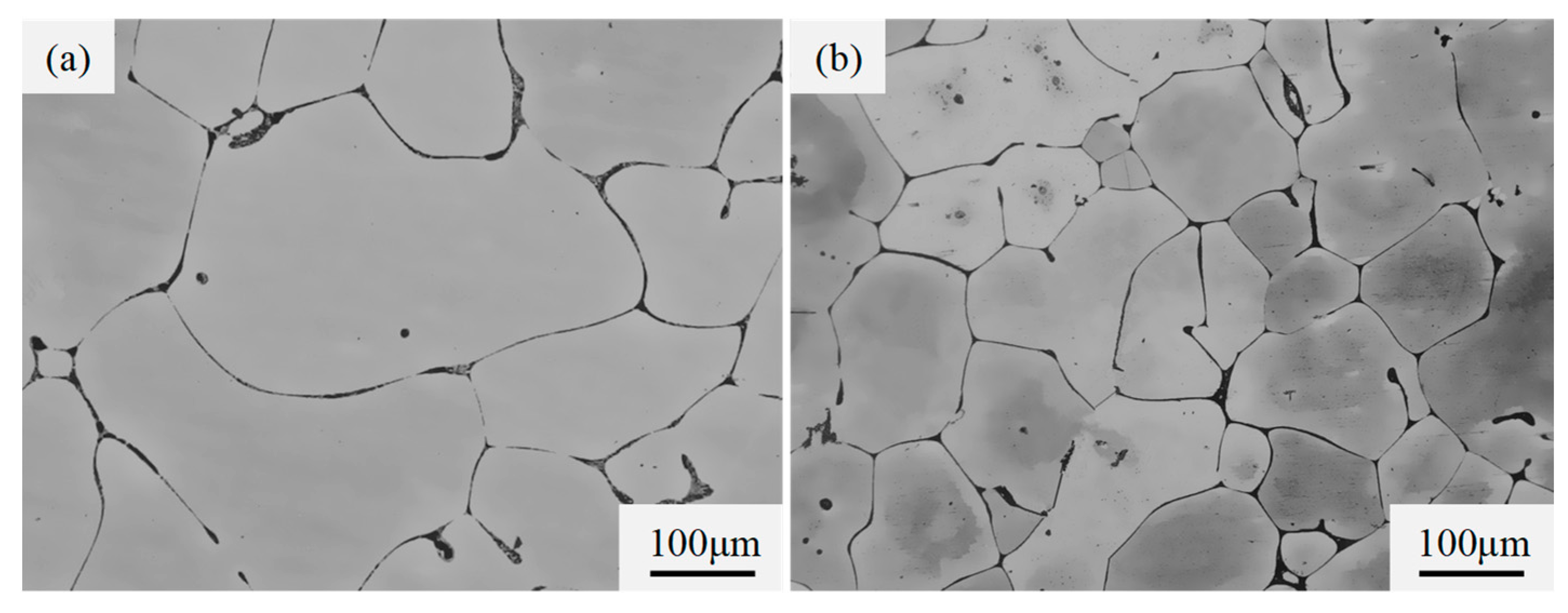
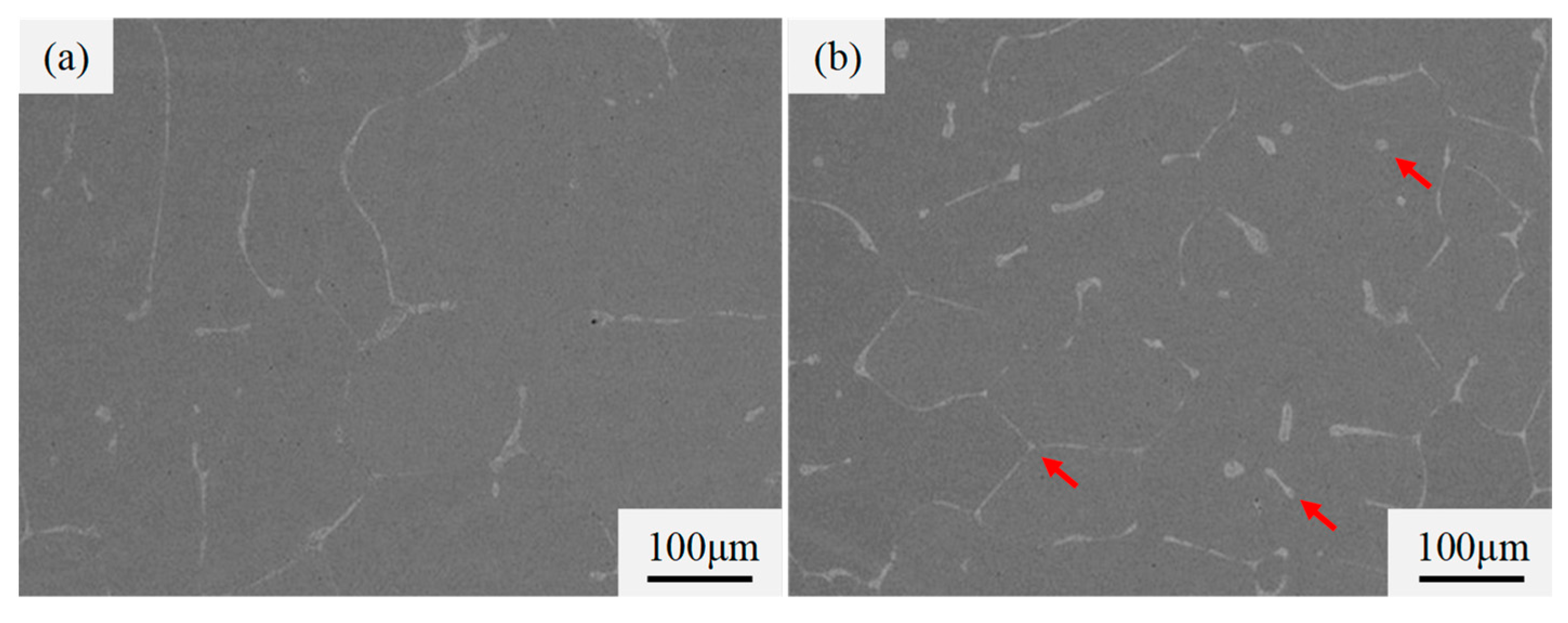
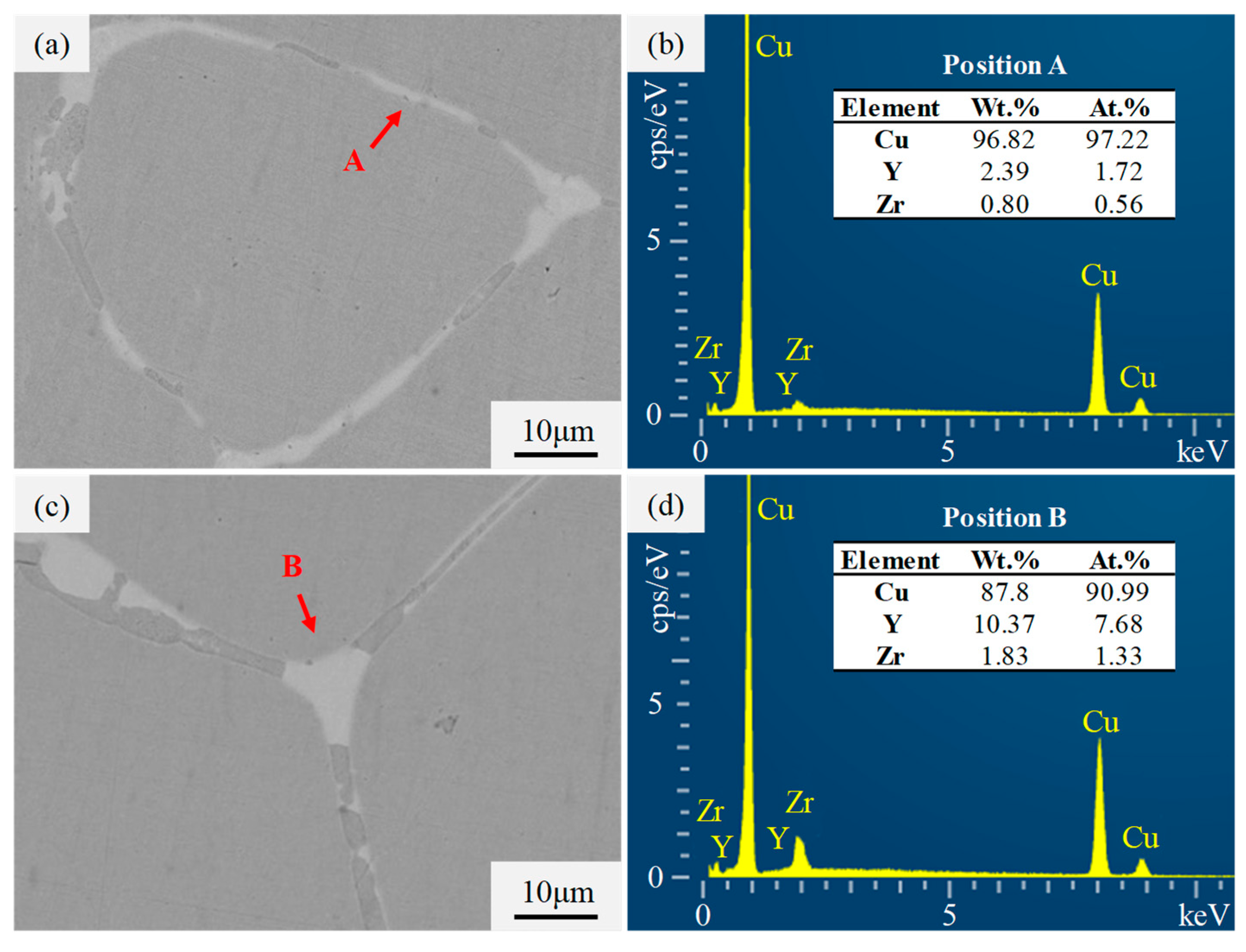
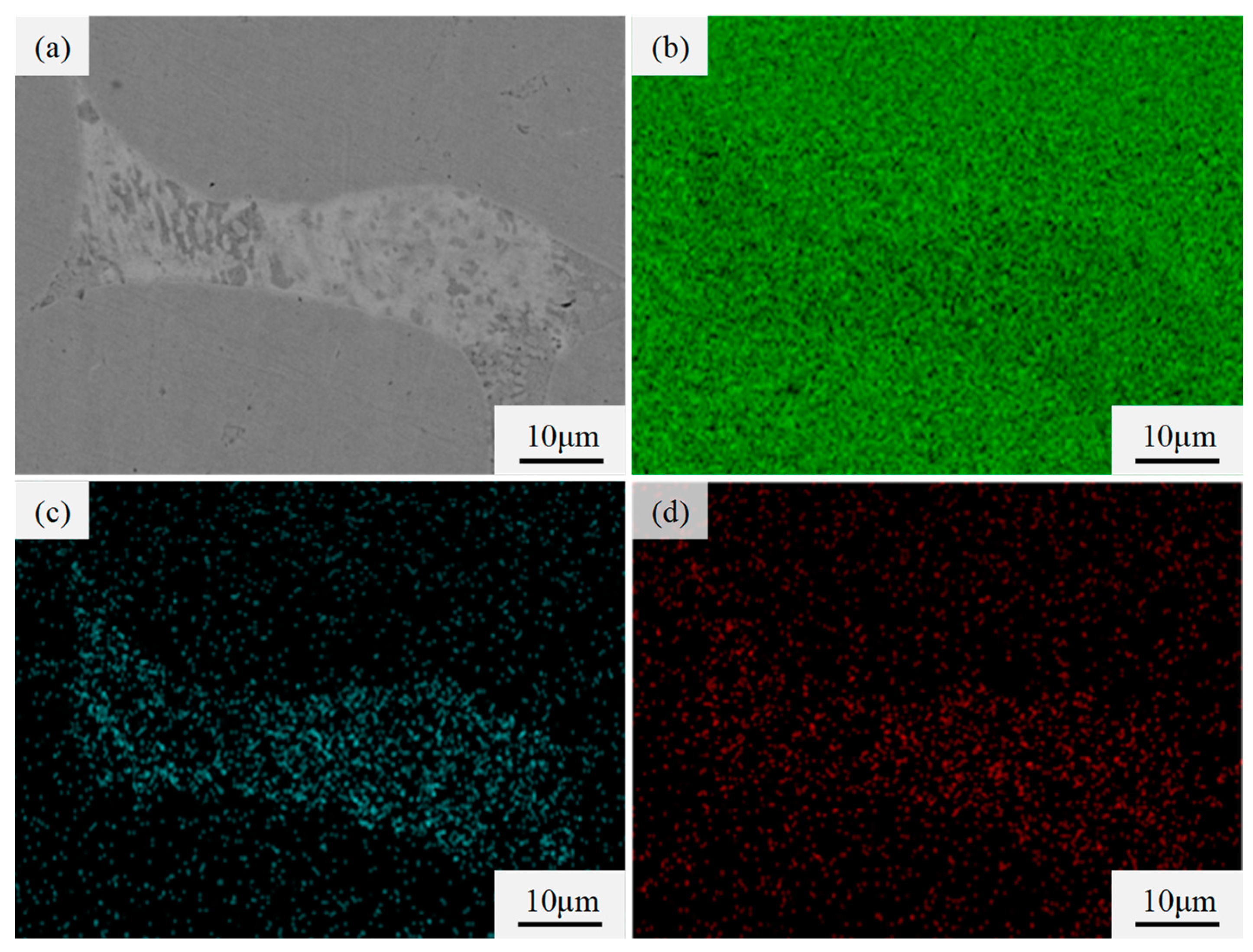
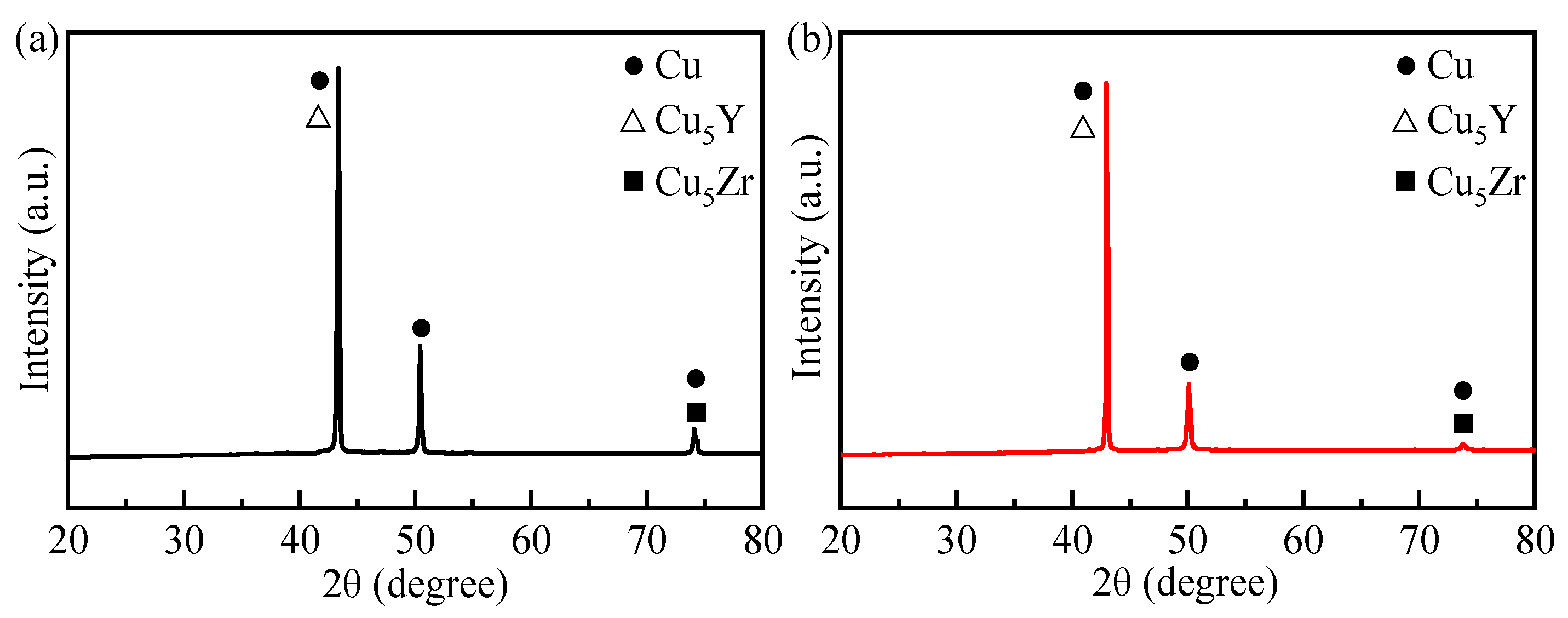
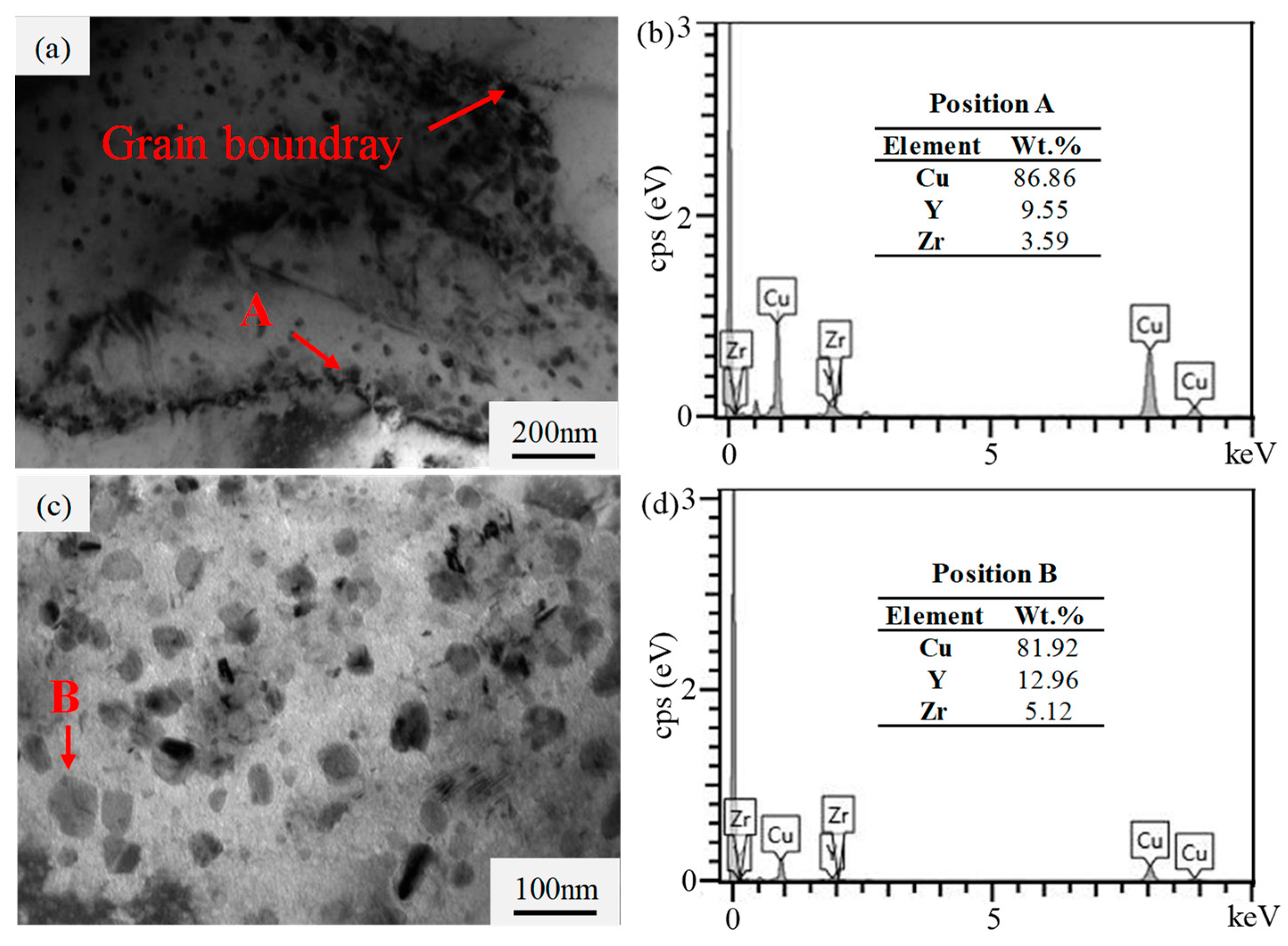
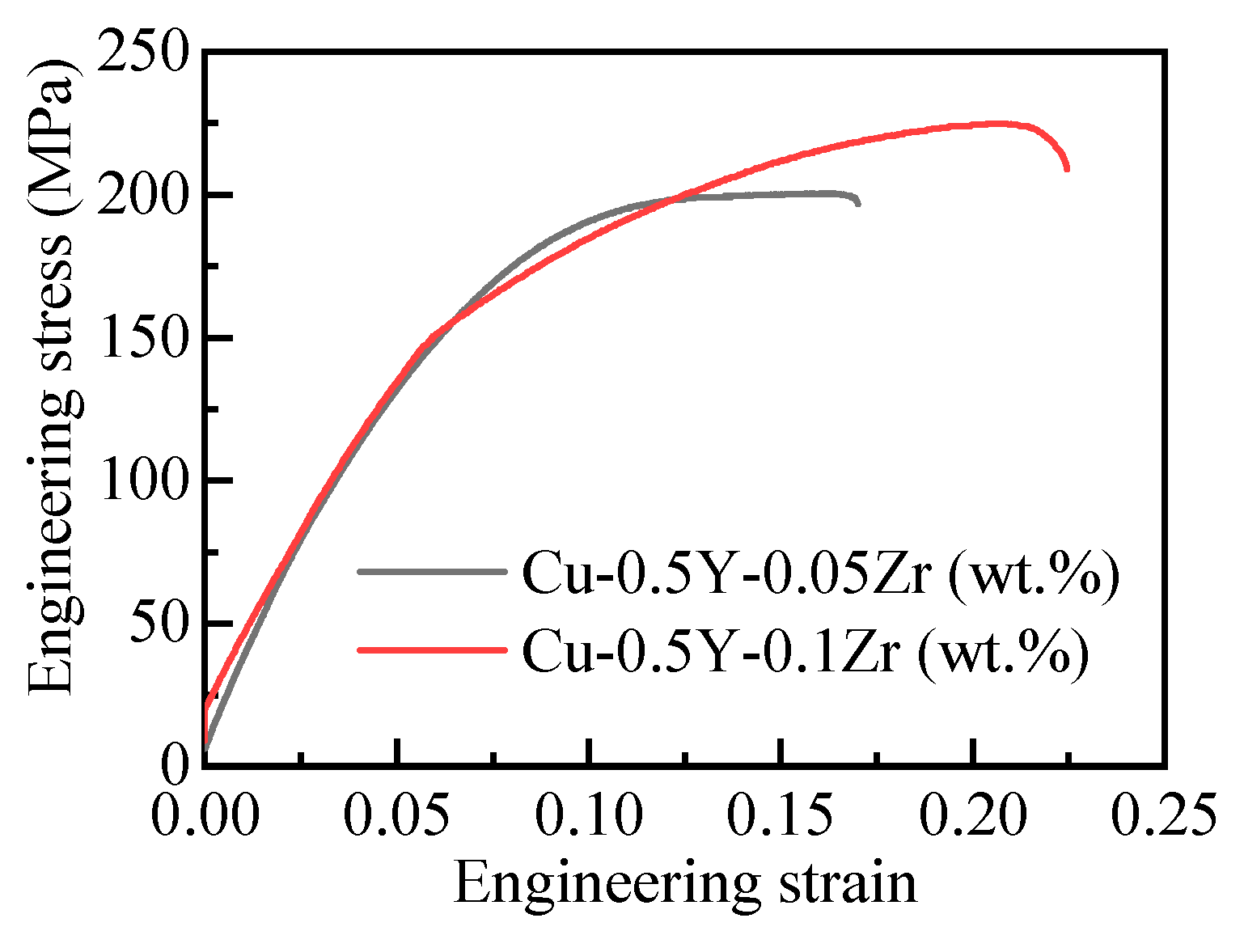
| Alloys | Y (wt.%) | Zr (wt.%) | Cu (wt.%) |
|---|---|---|---|
| Cu-0.5Y-0.05Zr | 0.480 | 0.048 | Balanced |
| Cu-0.5Y-0.1Zr | 0.511 | 0.099 | Balanced |
| Alloy | Ultimate Tensile Strength (MPa) | Elongation (%) | Reference |
|---|---|---|---|
| Cu | 145 ± 8 | 41.3 ± 5.0 | [19] |
| Cu-0.5Y-0.05Zr | 200 ± 10 | 17.0 ± 0.9 | Present study |
| Cu-0.5Y-0.1Zr | 225 ± 11 | 22.5 ± 1.1 | Present study |
© 2019 by the authors. Licensee MDPI, Basel, Switzerland. This article is an open access article distributed under the terms and conditions of the Creative Commons Attribution (CC BY) license (http://creativecommons.org/licenses/by/4.0/).
Share and Cite
Liang, D.; Wang, N.; Wang, Y.; Liu, Z.; Fu, Y. Effects of Zr, Y on the Microstructure and Properties of As-Cast Cu-0.5Y-xZr (wt.%) Alloys. Metals 2019, 9, 1084. https://doi.org/10.3390/met9101084
Liang D, Wang N, Wang Y, Liu Z, Fu Y. Effects of Zr, Y on the Microstructure and Properties of As-Cast Cu-0.5Y-xZr (wt.%) Alloys. Metals. 2019; 9(10):1084. https://doi.org/10.3390/met9101084
Chicago/Turabian StyleLiang, Dong, Ning Wang, Yuxiang Wang, Zhenjie Liu, and Ying Fu. 2019. "Effects of Zr, Y on the Microstructure and Properties of As-Cast Cu-0.5Y-xZr (wt.%) Alloys" Metals 9, no. 10: 1084. https://doi.org/10.3390/met9101084
APA StyleLiang, D., Wang, N., Wang, Y., Liu, Z., & Fu, Y. (2019). Effects of Zr, Y on the Microstructure and Properties of As-Cast Cu-0.5Y-xZr (wt.%) Alloys. Metals, 9(10), 1084. https://doi.org/10.3390/met9101084




